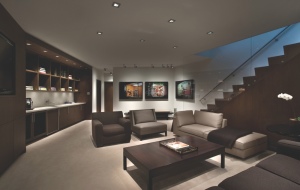Learn About Lighting

Accent lighting highlights artwork on the back wall and the shelving on the left. Photo courtesy of Cooper Lighting Lighting Design by 186 Lighting Design Group, Inc. Photography: Raul J. Garcia
Whether it’s illuminating art or architecture, accent lighting commands attention.
By Craig DiLouie, LC
What you need to know:
- The eye tends to focus on the brightest area in the field of view
- Accent lighting highlights things we want people to notice in a space
- Points of focus are created through contrasts in brightness or color
- Accent lighting should be flexible to accommodate changing focal points
- There are many options to control the light pattern and intensity
As its name suggests, accent lighting is about accenting a particular area or object within a space. Since our eyes tend to focus on the brightest area in the field of view, we can use light to showcase certain things in a space.
Attention-Grabbing Accents
Consider a room with a painting on the wall. If we used only uniform ambient lighting in this space, the painting would not stand out from the evenly illuminated wall. Functionally, it works, but visually the space is bland. The painting blends into the background.
Now suppose we add an adjustable downlight over the painting, aimed to place a higher lighting intensity onto it. The contrast in brightness between the painting and the surrounding area draws viewers’ eyes to the painting. We’ve now created a point of interest that is the first thing we notice when we enter the room. We could even do this in reverse, providing a higher light intensity behind an art object such as a sculpture through back lighting, showcasing its form via silhouetting.
Accent lighting also works great for highlighting architecture. Wall grazing is a form of accent lighting, while wallwashing, also considered ambient lighting, is related to accent lighting. With wall grazing, the light falls on the wall at a narrower angle, accentuating details through shadows. It’s ideal for spaces with textured walls, such as brick or stonework. In comparison, with wall washing the light falls on the wall at a wider angle, eliminating shadows and producing a visually clean, smooth surface. It’s ideal for spaces where we want to emphasize the form of the wall.
How to Apply Accent Lighting
The first step of accent lighting is to decide how you want a given space to look through layering—the combination of ambient, task and accent lighting. What do you want people to see? Deciding where we want the focus is the first step to building a visual hierarchy for the space.
The next step is to decide how to light it. Whatever method is used, the lighting must deliver enough punch to create a contrast between the object and its surround. Too little contrast, and people will not notice the object. Too much contrast, and you risk visual discomfort.
An important question to ask at this point is how much flexibility is needed. Anytime lighting is designed, it should take into account how the space is used, including future changes. For example, if we add an accent to a painting that is later removed, the lighting would then be accenting a blank space on a wall. For this reason, if artwork in a space is going to be moved around, the lighting should be able to be re-aimed or moved too. Flexible solutions include adjustable downlights that can be aimed at multiple spots from a fixed position, or track lights, which can be moved and aimed across the length of the track.
Directional point sources often are used to light art objects. These are small lamps that produce an intense light emission in a single direction, with features that can control the beam. Linear sources can work well with uniform lighting of large objects, shelving and architectural features.
When selecting accent lights, first decide how tight you want the focus on the object to be. Directional reflector lamps (light bulbs) are available in a range of distributions, from flood to spot to pin spot; the selected beam spread should match the form of the object or surface being lighted. Some lamps produce a very tight, focused beam pattern, with little or no spill light, while others light a wider area. So if we wanted to light a very tall, thin statue from above, we would want a very tight distribution with no spill light to light just the statue. We would use a slightly wider beam spread if we wanted some spill light on the pedestal, or an even wider distribution if we wanted to light more of the surround.